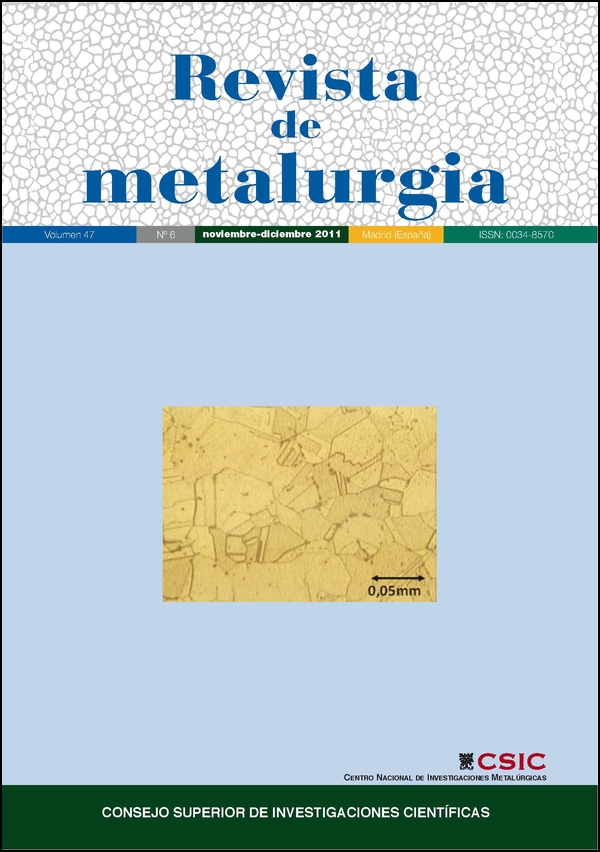New strategy for the optimal design and manufacture of high performance milling heads
DOI:
https://doi.org/10.3989/revmetalm.1101Keywords:
Milling head, Design, Finite element method (FEM), Aluminium foundry, Stainless steel insertsAbstract
High-performance mechanical-transmission heads are one of the most complex, costly and problematic parts of a milling machine, owing to the large amount of piping required for transporting fluids and to the high level of mechanical performance that is required from them. This study proposes a strategy for optimising the design and manufacture of head bodies by using aluminium alloys and by integrating tubular stainless steel inserts in the casting of the head. These tubular inserts that are integrated into the aluminium mass are an alternative to cooling conduits currently made by machine drilling. As demonstrated in the experimental validation of the first prototype, the new method has created a design that retains the same mechanical performance, increases its reliability and reduces the weight of the milling machine’s moving parts.
Downloads
References
[1] CECIMO Report 2009, Last trends in the European Machine Tool industry. Available at: http://www.cecimo.eu/index.php/machine-to.
[2] E. De Vries, Renewable Energy World Magazine, 10 (4) (2007) 1-10.
[3] R.M. del Toro-Matamoros, R.E. Haber, J. Palies and A. Bustillo, Rev. Metal. Madrid 44 (2008) 176-188
[4] D. Ancona and J. McVeigh, Wind Turbine - Materials and Manufacturing Fact Sheet, Princeton Energy Resources International, 2001, pp. 1-8.
[5] P. Sekler, A. Dietmair, A. Dadalau, H. Rüdele, J. Zulaika, J. Smolik and A. Bustillo, WT-Online 5 (2007) 320-327.
[6] A. Dietmair, A. Verl and P. Eberspächer, Int. J. Manuf. Res. 6 (2011) 380-327. http://dx.doi.org/10.1504/IJMR.2011.043238
[7] A. Dietmair and A. Verl, IEEE International Conference on Sustainable Energy Technology (ICSET), Singapore, 2008, pp. 524-579.
[8] J.A.W. Hijink and A.C.H. Van Der Wolf, 14th International Advances in Machine Tool Design and Research Conference, Manchester, England, 1973, pp. 553-558.
[9] S. Taylor and S.A. Tobias, 5th International Advances in Machine Tool Design and Research Conference, Birmingham, England, 1964, pp. 37-44.
[10] H. Sato, Y. Kuroda and M. Sagara, 14th International Advances in Machine Tool Design and Research Conference, Manchester, England, 1973, pp. 545-552.
[11] D.Te-Yen Huang and J.J. Lee, Int. J. Mach. Tools Manuf. 41 (2001) 1149-1163. http://dx.doi.org/10.1016/S0890-6955(01)00012-8
[12] Y.M. Zhang, X.L. Lin, X.D. Wang and G.Q. Cai, Mater. Sci. Forum, 471-472 (2004) 765-769. http://dx.doi.org/10.4028/www.scientific.net/MSF.471-472.765
[13] L.N. Lopez de Lacalle and A. Lamikiz, Machine Tools for High Performance Machining. (Ed.) Springer Verlag, 2009, pp. 58-60.
[14] N. Amaral, J.J. Rencis and Y.M. Rong, Int. J. Adv. Manuf. Technol. 25 (2005) 409-419. http://dx.doi.org/10.1007/s00170-003-1796-6
[15] M. Rantatalo, J. Aidanpää, B. Göransson and P. Norman, Int. J. Mach. Tools Manuf. 47 (2007) 1034-1045. http://dx.doi.org/10.1016/j.ijmachtools.2006.10.004
[16] Q.D. Yang, G.Q. Liu and K.S. Wang, Chin. J. Mech. Eng. 21 (2008) 103-107. http://dx.doi.org/10.3901/CJME.2008.06.103
[17] J. Smolik, 6th International Conference on High Speed Machining, San Sebastian, Spain, 2007, pp. 467-472.
[18] J.C. Love and V. Goodship, Multi-Material Injection Moulding. Smithers Rapra Technology, Shawbury (UK), 2002, pp. 9-22.
[19] Z.Y. Liu, D. Kent and G.B. Schaffer, Mater. Sci. Eng. A, 513-514, (2009) 352-56. http://dx.doi.org/10.1016/j.msea.2009.02.001
[20] D.F. Heaney, P. Suri and R.M. German, J. Mater. Sci. 38 (2003) 4869-4874. http://dx.doi.org/10.1023/B:JMSC.0000004407.63082.f1
[21] P. Imgrund, A. Rota, F. Petzoldt and A. Simchi, Int. J. Adv. Manuf. Technol. 33 (2007) 176-186. http://dx.doi.org/10.1007/s00170-006-0666-4
[22] Z.Y. Liu, D. Kent and G. B. Schaffer, Trans. A-Phys. Metall. Mater. Sci. 40A-12 (2009) 2785-2788.
[23] S. Mattei, A. Mathieu, A. Deschamps, B. Martin and D. Grevey, NDTE Int. 39 (2006) 272-276. http://dx.doi.org/10.1016/j.ndteint.2005.08.005
[24] F.W. Bach, A. Beniyash, K. Lau and R. Versemann, Adv. Mater. Res. 6-8 (2005) 143-150. http://dx.doi.org/10.4028/www.scientific.net/AMR.6-8.143
[25] P. Bertrand, Nomenclature International des Alliages d’Aluminium de fonderie. Editions techniques des Industries de la fonderie, Paris, 1986, pp. 34-37.
[26] P.J. Mikelonis, Foundry technology Source Book. American Society for Metals, Illinois, EE.UU., 1982, pp. 119-123.
[27] A. Dietmair, J. Zulaika, M. Sulitka, A. Bustillo and A. Verl, 17thCIRP International Conference On Life Cycle Engineering (LCE), Anhui, China, 2010, pp. 105-110.
[28] D. Dornfeld and D.Lee, Precision manufacturing. Springer Verlag, New York, EE.UU., 2008, pp. 37-49.
[29] M.A. Salgado, L.N. Lopez de Lacalle, A. Lamikiz, J. Muñoa and J.A. Sánchez, Int. J. Mach. Tools Manuf., 45 (2005) 727-739. http://dx.doi.org/10.1016/j.ijmachtools.2004.08.023
[30] E. Rivin, Stiffness and damping in mechanical design, Marcel Dekker Inc.,1999, pp. 273-288. [31] X. Liu and K. Cheng, Inter. J. Mach. Tools Manuf. 5 (2005) 1301-1320.
[32] I. Zaghbani and V. Songmene, Inter. J. Mach. Tools Manuf. 49 (12-13) (2009) 947-957. http://dx.doi.org/10.1016/j.ijmachtools.2009.06.010
[33] Norm ISO 1940-1, Mechanical vibration - Balance quality requirements for rotors in a constant (rigid) state - Part 1: Specification and verification of balance tolerances.
Downloads
Published
How to Cite
Issue
Section
License
Copyright (c) 2011 Consejo Superior de Investigaciones Científicas (CSIC)

This work is licensed under a Creative Commons Attribution 4.0 International License.
© CSIC. Manuscripts published in both the printed and online versions of this Journal are the property of Consejo Superior de Investigaciones Científicas, and quoting this source is a requirement for any partial or full reproduction.
All contents of this electronic edition, except where otherwise noted, are distributed under a “Creative Commons Attribution 4.0 International” (CC BY 4.0) License. You may read the basic information and the legal text of the license. The indication of the CC BY 4.0 License must be expressly stated in this way when necessary.
Self-archiving in repositories, personal webpages or similar, of any version other than the published by the Editor, is not allowed.
















